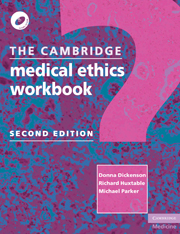Book contents
- Frontmatter
- Contents
- List of cases
- List of papers
- Preface to the second edition
- Preface to the first edition
- Cases in medical ethics and law: an interactive tutorial
- 1 Death and dying: decisions at the end of life
- 2 Reproduction: decisions at the start of life
- 3 Genetics: information, access and ownership
- 4 Medical research: participation and protection
- 5 Mental health: consent, competence and caring
- 6 Long-term care: autonomy, ageing and dependence
- 7 Children and young people: conflicting responsibilities
- 8 Resource allocation: justice, markets and rationing
- 9 Thinking about ethics: autonomy and patient choice
- Appendix 1 Study guide for teachers
- Appendix 2 Using keywords to explore this book
- Bibliography
- Index
Appendix 2 - Using keywords to explore this book
- Frontmatter
- Contents
- List of cases
- List of papers
- Preface to the second edition
- Preface to the first edition
- Cases in medical ethics and law: an interactive tutorial
- 1 Death and dying: decisions at the end of life
- 2 Reproduction: decisions at the start of life
- 3 Genetics: information, access and ownership
- 4 Medical research: participation and protection
- 5 Mental health: consent, competence and caring
- 6 Long-term care: autonomy, ageing and dependence
- 7 Children and young people: conflicting responsibilities
- 8 Resource allocation: justice, markets and rationing
- 9 Thinking about ethics: autonomy and patient choice
- Appendix 1 Study guide for teachers
- Appendix 2 Using keywords to explore this book
- Bibliography
- Index
Summary
In this appendix we have mapped The Cambridge Medical Ethics Workbook against the most commonly used keywords scheme in medical ethics: the Kennedy Institute of Bioethics classification (otherwise known as the National Reference Center for Bioethics Literature Library Classification Scheme).
For some chapters in this book, such as Chapters 1 (Death and dying: decisions at the end of life) and 2 (Reproduction: decisions at the start of life), there are copious and obvious Kennedy keywords, whereas other chapters appear at first to be less well matched to the scheme. Chapters 6 (Long-term care: autonomy, ageing and dependence) and 7 (Children and young people: conflicting responsibilities) are both major topics to us, whereas neither occupies more than a sub-sub-heading in the Kennedy Institute classification. This difference in emphasis should not, of course, be taken to imply that Chapters 1 and 2 are richer or more ‘heavyweight’ than Chapters 6 and 7. As it turns out, the list of keywords for Chapter 6 is no shorter than that for Chapters 1 or 2, because in the course of dealing with everyday ethical issues that arise in the care of the elderly, we cover major topics such as truth-telling, disclosure and conflicting ethical principles. Chapter 7 actually garnered the longest list of cross-references of any topic, including confidentiality, right to refuse treatment, and availability of genetic testing, abortion counselling or HIV testing to minors. In the end, then, the classification system did prove productive and appropriate for these chapters, despite initial appearances.
- Type
- Chapter
- Information
- The Cambridge Medical Ethics Workbook , pp. 221 - 224Publisher: Cambridge University PressPrint publication year: 2010



